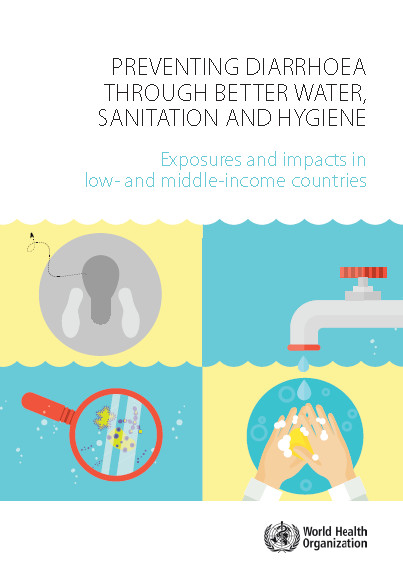Preventing diarrhoea through better water, sanitation and hygiene: exposures and impacts in low- and middle-income countries
 |
rapport Dec 2014
Ed. WHO - Genève ; Isbn: 978 92 4 156482 3
Téléchargeable sous format: PdF
Téléchargeable chez l'éditeur
Page de présentation d'un éditeur
Abstract:
Exposures
Direct use of drinking-water from unimproved sources (without household water treatment)ranged from 3% to 38% by region, with an overall average of 12% among LMICs. Regional averages for access to piped water on premises ranged from 19% to 88%, with an LMIC average of 49% (Table 1), although this figure includes intermittent and poorly managed piped supplies which may be microbially compromised.
Use of unimproved sanitation facilities ranged from 13% to 65% by region (Table 2). This proportion includes those who share an improved facility among two or more households.
Approximately 19% of the world’s population washes hands with soap after contact with excreta. This proportion is estimated to range between 13% and 17% in LMIC regions, and from 43% to 49% in high-income regions (Figure 13).
Impacts of interventions
A modest reduction in diarrhoea (e.g. 11–16%) can be achieved through use of basic improved water or sanitation facilities, such as protected wells or improved latrines (Figures 6 and 11). The health benefit is limited because these drinking-water sources may be microbially contaminated and because basic sanitation may not adequately protect the wider community from exposure to excreta.
Diarrhoea can be reduced significantly if water quality can be ensured up to the point-of-consumption. Effective and consistent application of household water treatment and safe storage can reduce diarrhoeal disease by between 28% and 45%, depending on the type of water supply (Figure 6).
Limited evidence suggests that major diarrhoea reductions (e.g. 73%) can be achieved by transitioning to services that confer safe and continuous piped water supply (Figure 6).
Similarly, limited evidence suggests that connection to a sewerage system that safely removes excreta from both the household and community yields great health benefits. • Handwashing reduces the risk of diarrhoeal disease by 40%, however when an adjustment for unblinded studies was included, the effect estimate was reduced to 23% and became statistically nonsignificant.
Global burden of disease
842 000 deaths in LMICs are caused by inadequate WASH, representing 58% of total diarrhoeal deaths, and 1.5% of the total disease burden.
Separated out by individual risk factor, 502 000 deaths can be attributed to unsafe and insufficient drinking-water, 280 000 deaths result from inadequate sanitation, and another 297 000 are due to inadequate handwashing. Because some people are exposed to multiple risk factors, the sum of deaths attributable to individual risk factors is different from when the risk factors are considered together.
Diarrhoeal deaths among children under-five have more than halved from 1.5 million in 1990 to 622 000 in 2012. Inadequate WASH accounts for 361 000 of these deaths, or over 1000 child deaths per day.
The current global burden of disease estimate of the impact of inadequate WASH (i.e. 58% of total diarrhoeal deaths) is substantially lower than the WHO 2000 estimate of 88%. This is attributed to a number of factors including the fall in global diarrhoeal deaths from 2.2 million in 2000 to 1.5 million in 2012 and the use of a far more conservative counterfactual, which retains a significant risk of diarrhoeal illness.
Health impacts of poor WASH on diseases other than on diarrhoea have not been updated in this study. However, earlier work showed that poor water, sanitation, and hygiene have a major impact on undernutrition, and also on a number of neglected tropical diseases including schistosomiasis, trachoma and soil-transmitted helminths (intestinal worms).
Water resource management also impacts on vector-borne diseases such as malaria and dengue fever, and accidental deaths through drowning. The findings of this report underscore the importance of enabling universal access to at least a basic level of drinkingwater and sanitation service.
The report also suggests that that there are likely to be major health benefits from raising service levels to safe and continuous water supply and to connection to a sewerage system. Limited data suggest that these higher levels of services could significantly reduce diarrhoeal disease. These findings are consistent with WHO Guidelines which emphasize continuous improvements to protect public health.
Mots clefs: |
hygiène (CI) (DT) (OP) (ope) , lavage des mains, savon (CI) (DT) (OP) (ope) , maladie (CI) (DT) (OP) (ope) |
Editeur/Diffuseur: |
|
WHO
-
World Health Organization - Genève - Suisse |
En cas de lien brisé, nous le mentionner à communication@pseau.org